Effect of Slot at Blade Root on Compressor Cascade Performance under Different Aerodynamic Parameters
Abstract
:1. Introduction
2. Numerical Methods
2.1. Cascade Model
2.2. Grid and Numerical Technique
2.3. Validation of the Simulation Results
3. Results and Discussions
3.1. Effect of Pitch-Chord Ratio
3.2. Effect of Aspect Ratio
3.3. Effect of Blade Fillet
4. Conclusions
- (a)
- High pitch-chord ratio blades are inclined to stall with the increase of the loading for each blade. With the slot configuration, the overall performance of the high pitch-chord ratio cascade is almost the same with reference to low pitch-chord ratio by reducing the corner separation in the cascade. Therefore, a slot can be used to decrease the number of blades to improve the thrust-weight ratio and to avoid large separation caused by the high loading of the blade.
- (b)
- High aspect ratio blades are also inclined to stall. For the low aspect ratio, flow becomes three-dimensional almost over the entire blade span and the influence of the corner separation plays a more important role in the flow passage. For all of the aspect ratios studied, slot configuration still has a positive effect on the corner separation and the overall performance of the cascade has been improved.
- (c)
- For the PVD cascade investigated in this study, flow near the endwall has shown some improvement, while a radical shift of the results is also evident. For the blade with fillet more studies are required to be carried out to understand the relationship between blade fillet, slot configuration, and the corner separation.
Acknowledgments
Author Contributions
Conflicts of Interest
References
- Wisler, D.C. Loss reduction in axial-flow compressors through low-speed model testing. J. Eng. Gas Turbines Power 1985, 107, 354–363. [Google Scholar] [CrossRef]
- Zambonini, G.; Ottavy, X. Unsteady pressure investigations of corner separated flow in a linear compressor cascade. In Proceedings of the ASME Turbo Expo 2015: Turbine Technical Conference and Exposition, Montreal, QC, Canada, 15–19 June 2015.
- Zambonini, G.; Ottavy, X.; Kriegseis, J. Corner Separation Dynamics in a Linear Compressor Cascade. In Proceedings of the ASME Turbo Expo 2016: Turbomachinery Technical Conference and Exposition, Seoul, Korea, 13–17 June 2016.
- Liu, Y.; Yan, H.; Lu, L.; Li, Q. Investigation of Vortical Structures and Turbulence Characteristics in Corner Separation in a Linear Compressor Cascade Using DDES. ASME J. Fluids Eng. 2016. [Google Scholar] [CrossRef]
- Wang, Z.; Yuan, X. Unsteady mechanisms of compressor corner separation over a range of incidences based on hybrid LES/RANS. In Proceedings of the ASME Turbo Expo 2013: Turbine Technical Conference and Exposition, San Antonio, TX, USA, 3–7 June 2013.
- Gao, F.; Ma, W.; Zambonini, G.; Boudet, J.; Ottavy, X.; Lu, L.; Shao, L. Large-eddy simulation of 3-D corner separation in a linear compressor cascade. Phys. Fluids 2015, 27, 085105. [Google Scholar] [CrossRef]
- Zweifel, O. The spacing of turbo-machine blading, especially with large angular deflection. Brown Boveri Rev. 1945, 32, 436–444. [Google Scholar]
- Lieblein, S.; Schwenk, F.C.; Broderick, R.L. Diffusion Factor for Estimating Losses and Limiting Blade Loadings in Axial-Flow-Compressor Blade Elements; No. NACA-RM-E53D01; National Advisory Committee for Aeronautics, Lewis Flight Propulsion Lab: Cleveland, OH, USA, 1953.
- Obrecht, T. HP compressor preliminary design. In Advances in Axial Compressor Aerodynamics; Von Karman Institute for Fluid Dynamics Lecture Series VKI-LS 3; Von Karman Institute for Fluid Dynamics: Sint-Genesius-Rode, Belgium, 2013. [Google Scholar]
- Sans, J.; Resmini, M.; Brouckaert, J.F.; Hiernaux, S. Numerical investigation of the solidity effect on linear compressor cascades. In Proceedings of the ASME Turbo Expo 2014: Turbine Technical Conference and Exposition, Dusseldorf, Germany, 16–20 June 2014.
- Wennerstrom, A.J. Low aspect ratio axial flow compressors: Why and what it means. J. Turbomach. 1989, 111, 357–365. [Google Scholar] [CrossRef]
- Goodhand, M.N.; Miller, R.J. The impact of real geometries on three-dimensional separations in compressors. J. Turbomach. 2012, 134, 021007. [Google Scholar] [CrossRef]
- Curlett, B.P. The Aerodynamic Effect of Fillet Radius in a Low Speed Compressor Cascade; NASA TM-105347; NASA Lewis Research Center: Cleveland, OH, USA, November 1991.
- Brockett, W.; Andrew, K. Small Axial Turbine Stator Technology Program; NASA CR-165602; NASA: Stratford, CT, USA, April 1982.
- Stratford, B.S. The prevention of separation and flow reversal in the corners of compressor blade cascades. Aeronaut. J. 1973, 77, 249–256. [Google Scholar]
- Tweedt, D.L.; Okiishi, T.H. Stator Blade Row Geometry Modification Influence on Two-Stage, Axial-Flow Compressor Aerodynamic Performance; No. ISU-ERI-AMES-84179; Iowa State Univ Ames Engineering Research Inst.: Ames, IA, USA, 1983. [Google Scholar]
- Meyer, R.; Schulz, S.; Liesner, K.; Passrucker, H.; Wunderer, R. A parameter study on the influence of fillets on the compressor cascade performance. J. Theor. Appl. Mech. 2012, 50, 131–145. [Google Scholar]
- Siemann, J.; Krenz, I.; Seume, J.R. Experimental Investigation of Aspiration in a Multi-Stage High-Speed Axial-Compressor. In Proceeding of the ASME Turbo Expo 2016: Turbomachinery Technical Conference and Exposition, Seoul, Korea, 13–17 June 2016.
- Liesner, K.; Meyer, R.; Lemke, M.; Gmelin, C.; Thiele, F. On the efficiency of secondary flow suction in a compressor cascade. In Proceedings of the ASME Turbo Expo 2010: Power for Land, Sea, and Air, Glasgow, UK, 14–18 June 2010.
- Liesner, K.; Meyer, R.; Schulz, S. Non-symmetrical boundary layer suction in a compressor cascade. J. Theor. Appl. Mech. 2012, 50, 455–472. [Google Scholar]
- Ramzi, M.; AbdErrahmane, G. Passive Control via Slotted Blading in a Compressor Cascade at Stall Condition. J. Appl. Fluid Mech. 2013, 6, 571–580. [Google Scholar]
- Ramzi, M.; Gérard, B.; Abderrahmane, G. Numerical study of passive control with slotted blading in highly loaded compressor cascade at low Mach number. Int. J. Fluid Mach. Syst. 2011, 4, 97–103. [Google Scholar] [CrossRef]
- Zhou, M.; Wang, R.; Bai, Y.; Zeng, L. Numerical research on effect of stator blade slot treatment on single stage compressor characteristic. Acta Aerodyn. Sin. 2008, 26, 0258. (In Chinese) [Google Scholar]
- Zhou, M.; Wang, R.; Cao, Z.; Zhang, X. Research on effect of slot inlet angle and turning angle on the flow field characteristic of cascade. J. Aerospace Power 2008, 1, 021. (In Chinese) [Google Scholar]
- Mu, X.; Lu, L. Corner separation control by bleed slot at the root of blade. Gas Turbine Exp. Res. 2007, 20, 28–33. (In Chinese) [Google Scholar]
- Gbadebo, S.A.; Cumpsty, N.A.; Hynes, T.P. Three-dimensional separations in axial compressors. J. Turbomach. 2005, 127, 331–339. [Google Scholar] [CrossRef]
- Gbadebo, S.A.; Cumpsty, N.A.; Hynes, T.P. Control of three-dimensional separations in axial compressors by tailored boundary layer suction. J. Turbomach. 2008, 130, 011004. [Google Scholar] [CrossRef]
- Liu, Y.; Yan, H.; Liu, Y.; Lu, L.; Li, Q. Numerical Study of Corner Separation in a Linear Compressor Cascade Using Various Turbulence Models. Chin. J. Aeronaut. 2016, 29, 639–652. [Google Scholar] [CrossRef]
- Liu, Y.; Yan, H.; Fang, L.; Lu, L.; Li, Q.; Shao, L. Modified k-ω model Using Kinematic Vorticity for Corner Separation in Compressor Cascade. Sci. China Technol. Sci. 2016, 59, 795–806. [Google Scholar] [CrossRef]
- Liu, Y.; Lu, L.; Fang, L.; Gao, F. Modification of Spalart–Allmaras Model with Consideration of Turbulence Energy Backscatter Using Velocity Helicity. Phys. Lett. A 2011, 375, 2377–2381. [Google Scholar] [CrossRef]
- Liu, Y.; Yan, H.; Lu, L. Numerical Study of the Effect of Secondary Vortex on Three-Dimensional Corner Separation in a Compressor Cascade. Int. J. Turbo Jet-Engines 2016, 33, 9–18. [Google Scholar] [CrossRef]
- Liu, Y.; Sun, J.; Lu, L. Corner separation control by boundary layer suction applied to a highly loaded axial compressor cascade. Energies 2014, 7, 7994–8007. [Google Scholar] [CrossRef]
- Gbadebo, S.A. Three-Dimensional Separational in Compressors. Ph.D. Thesis, University of Cambridge, London, UK, 2003. [Google Scholar]
- Lei, V.M.; Spakovszky, Z.S.; Greitzer, E.M. A criterion for axial compressor hub-corner stall. J. Turbomach. 2008, 130, 031006. [Google Scholar] [CrossRef]
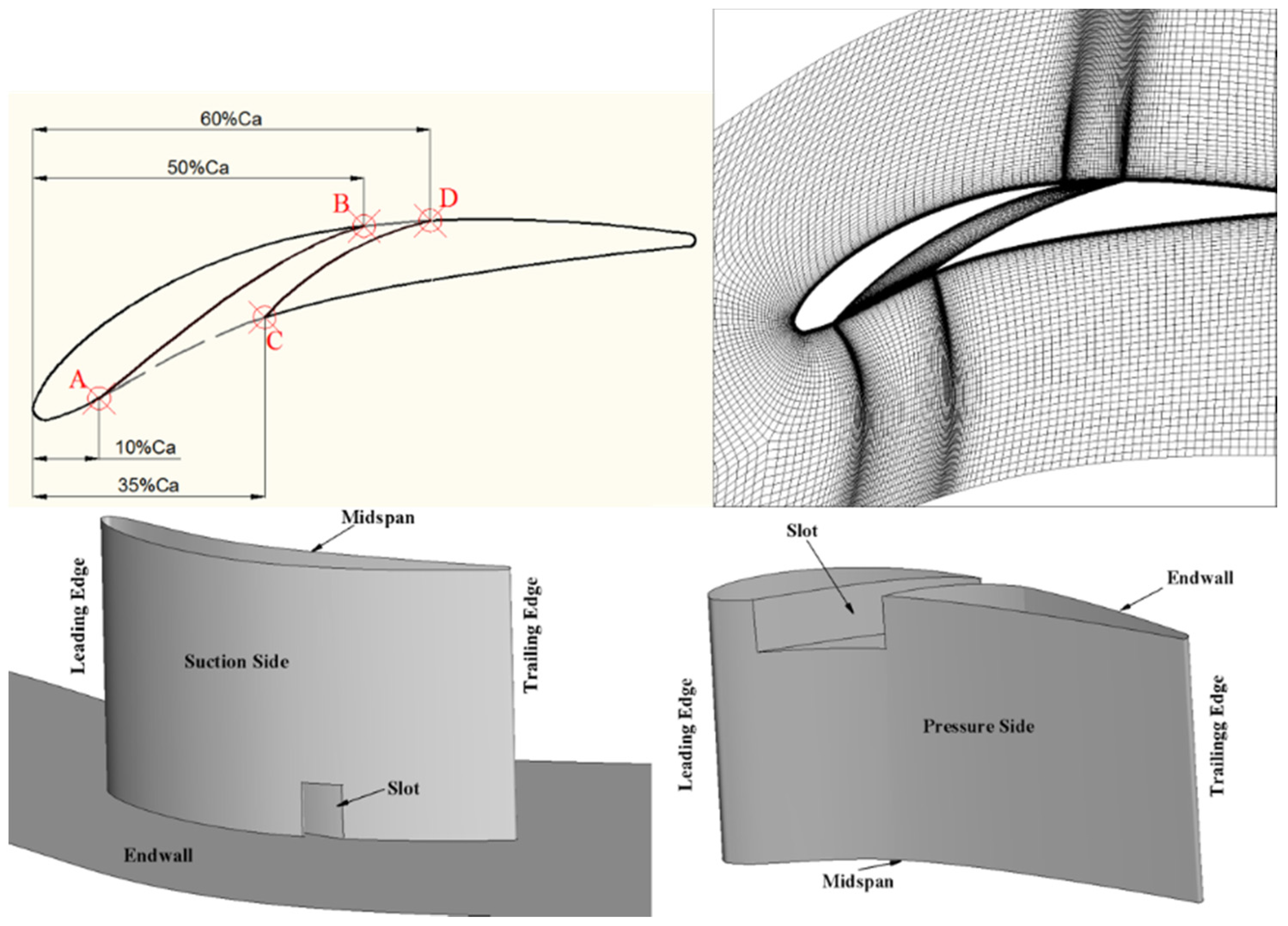
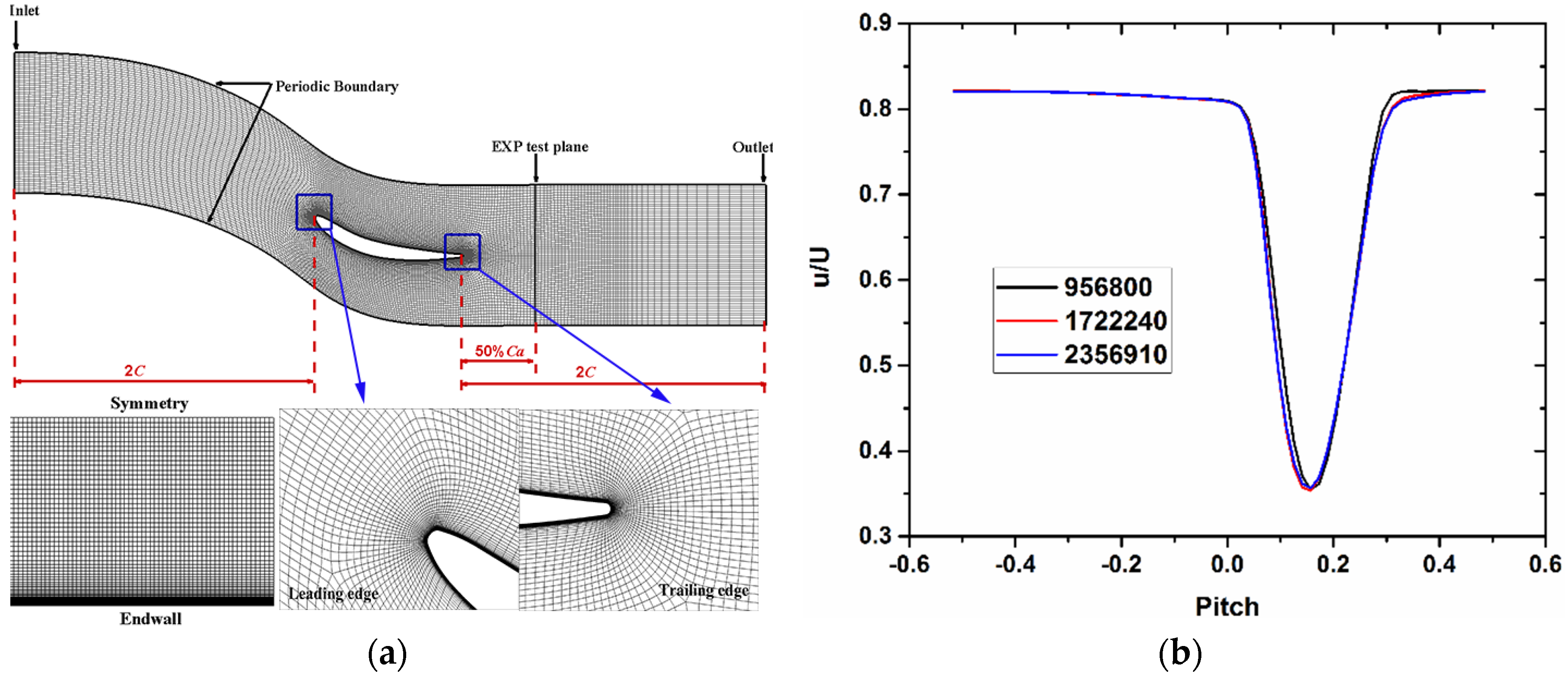
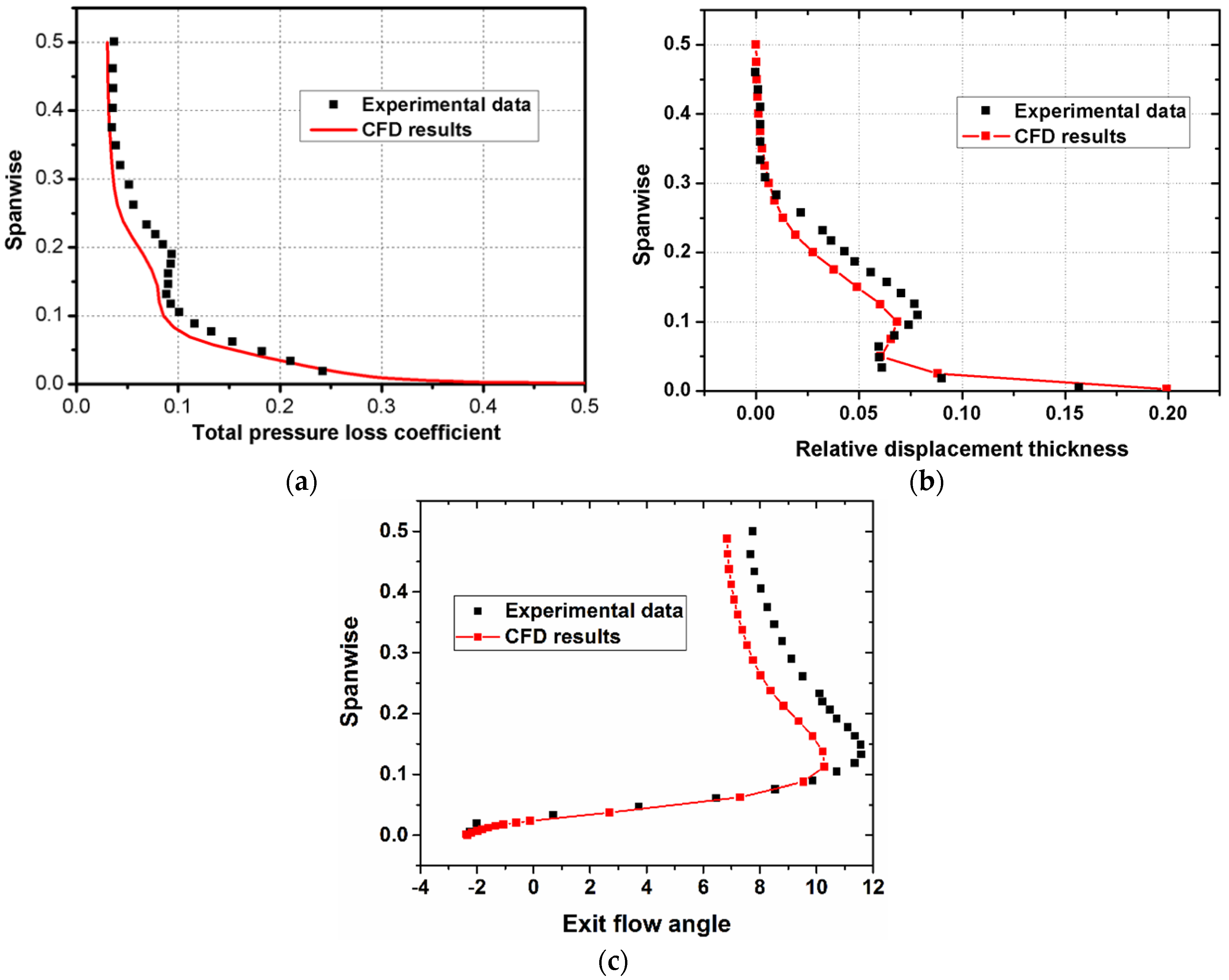

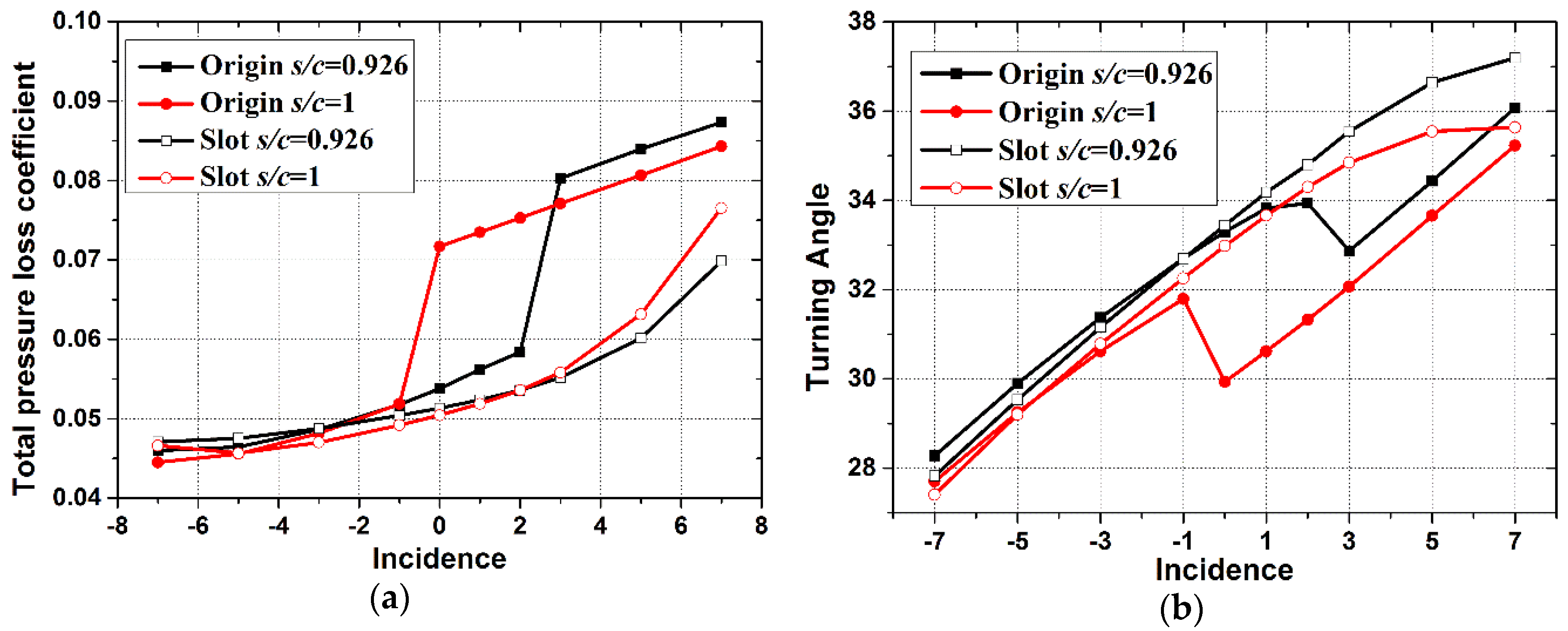
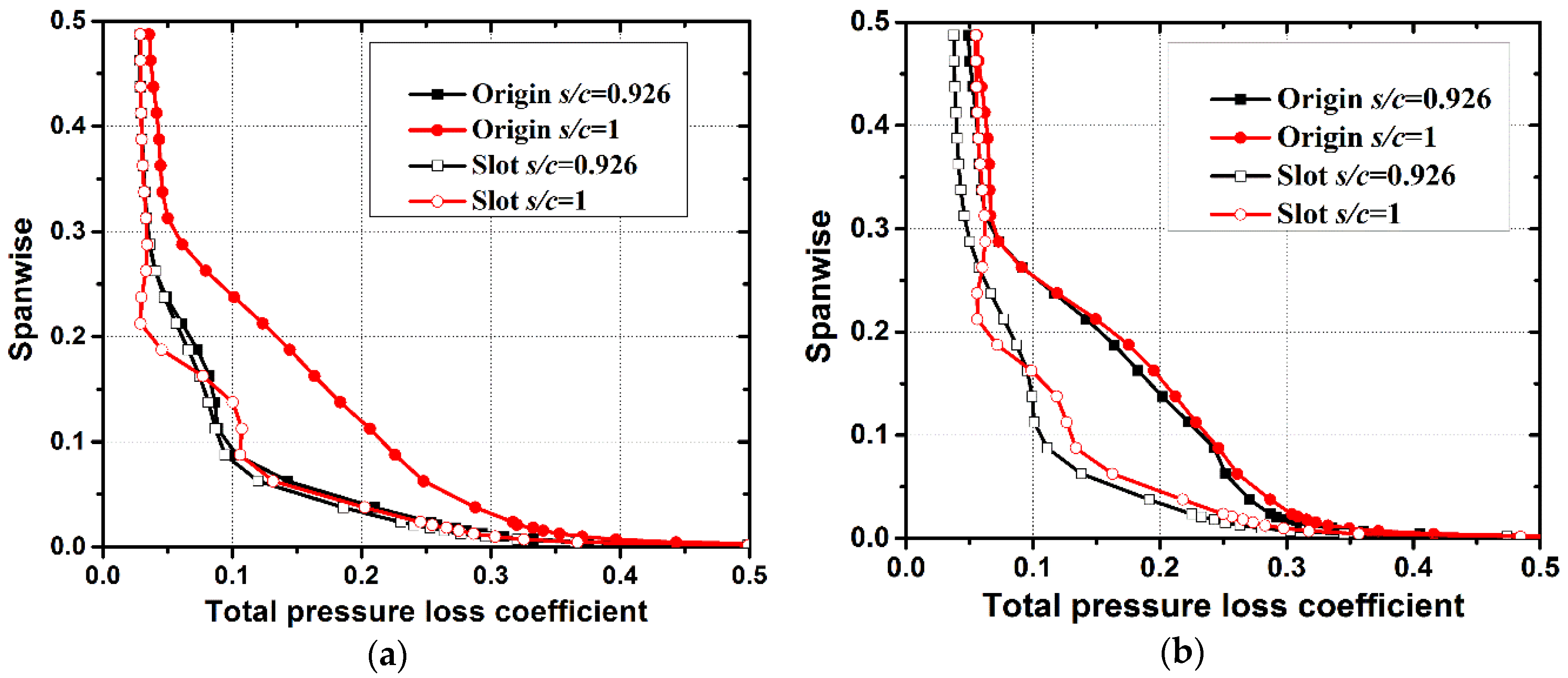
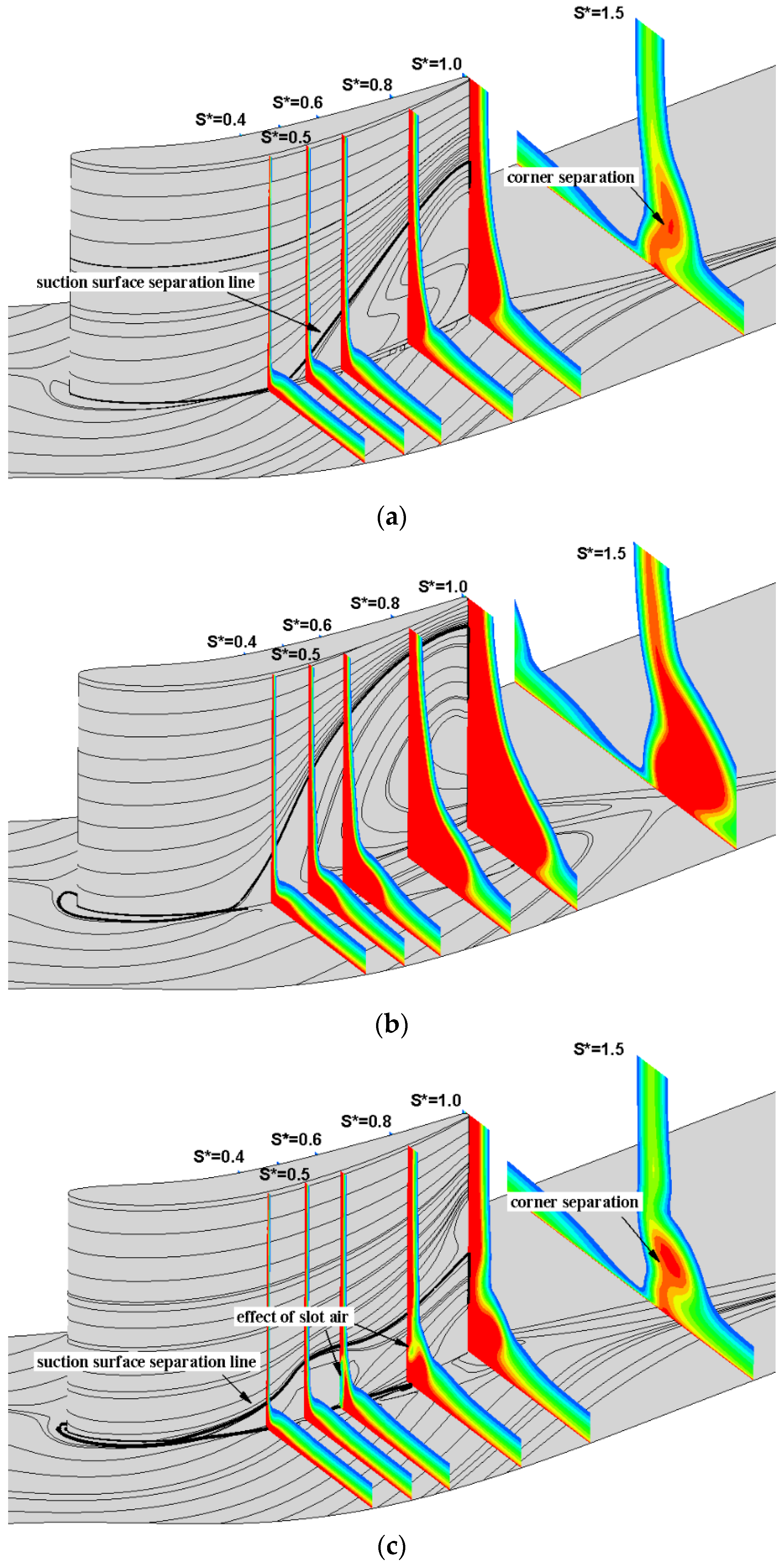
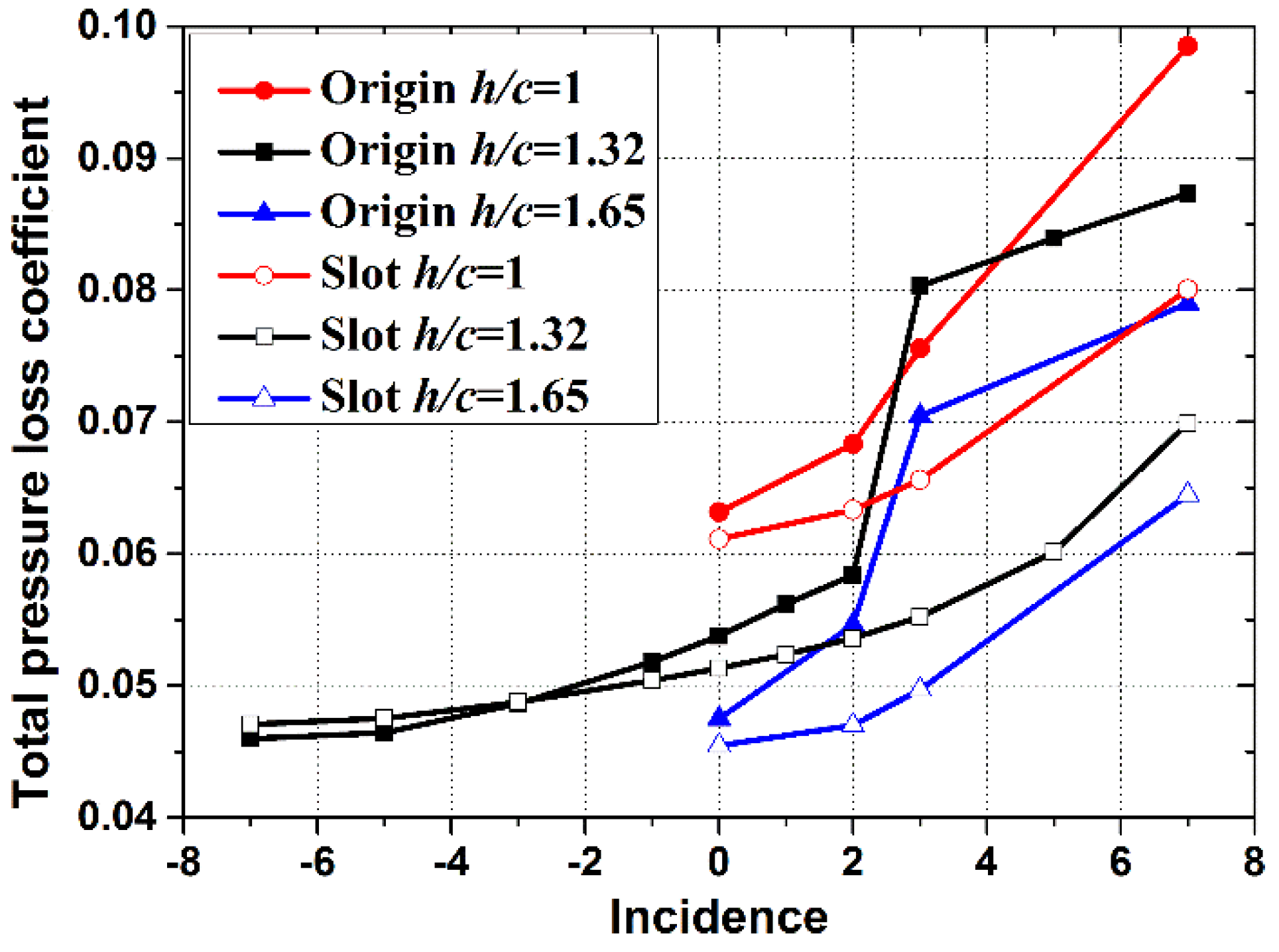

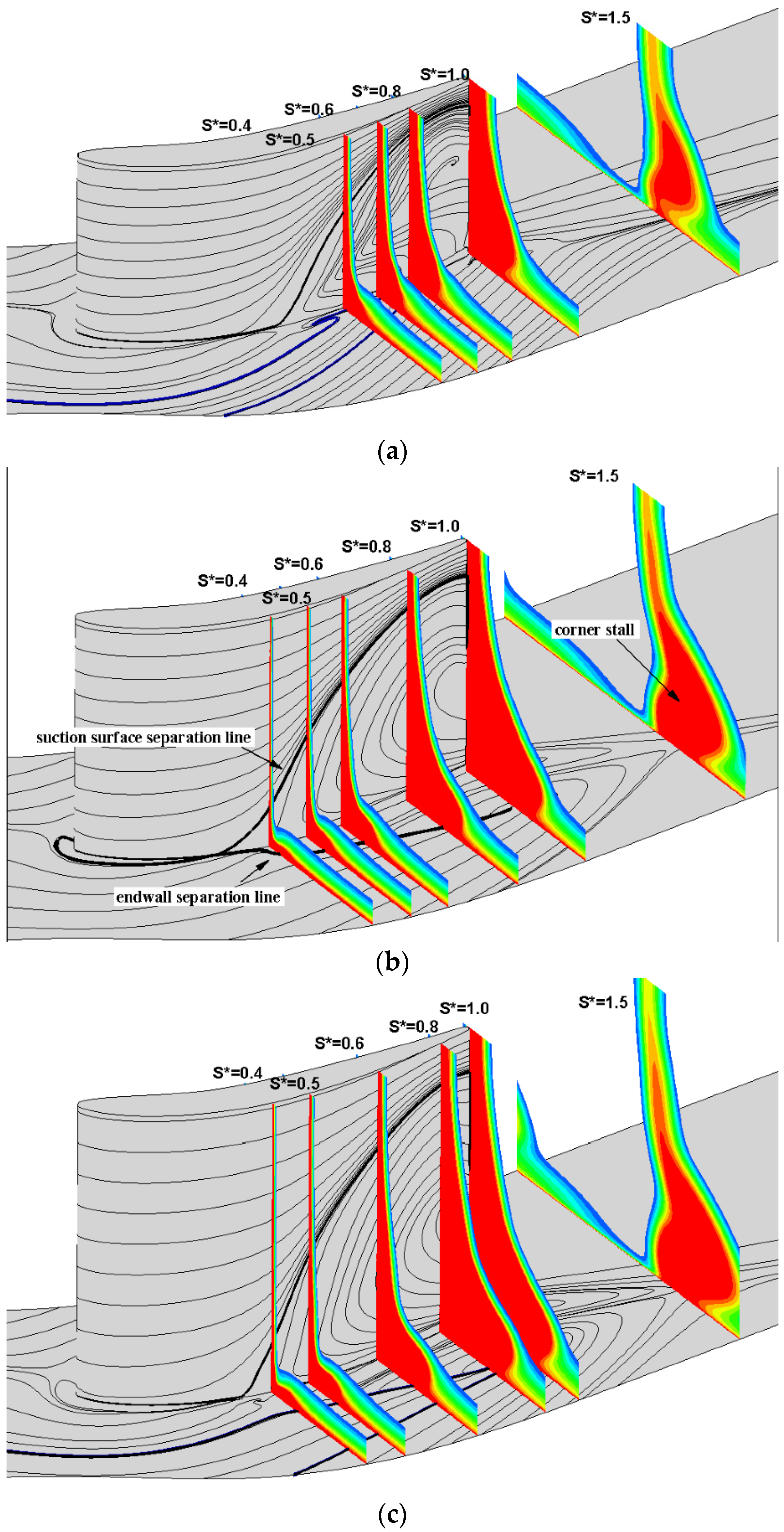
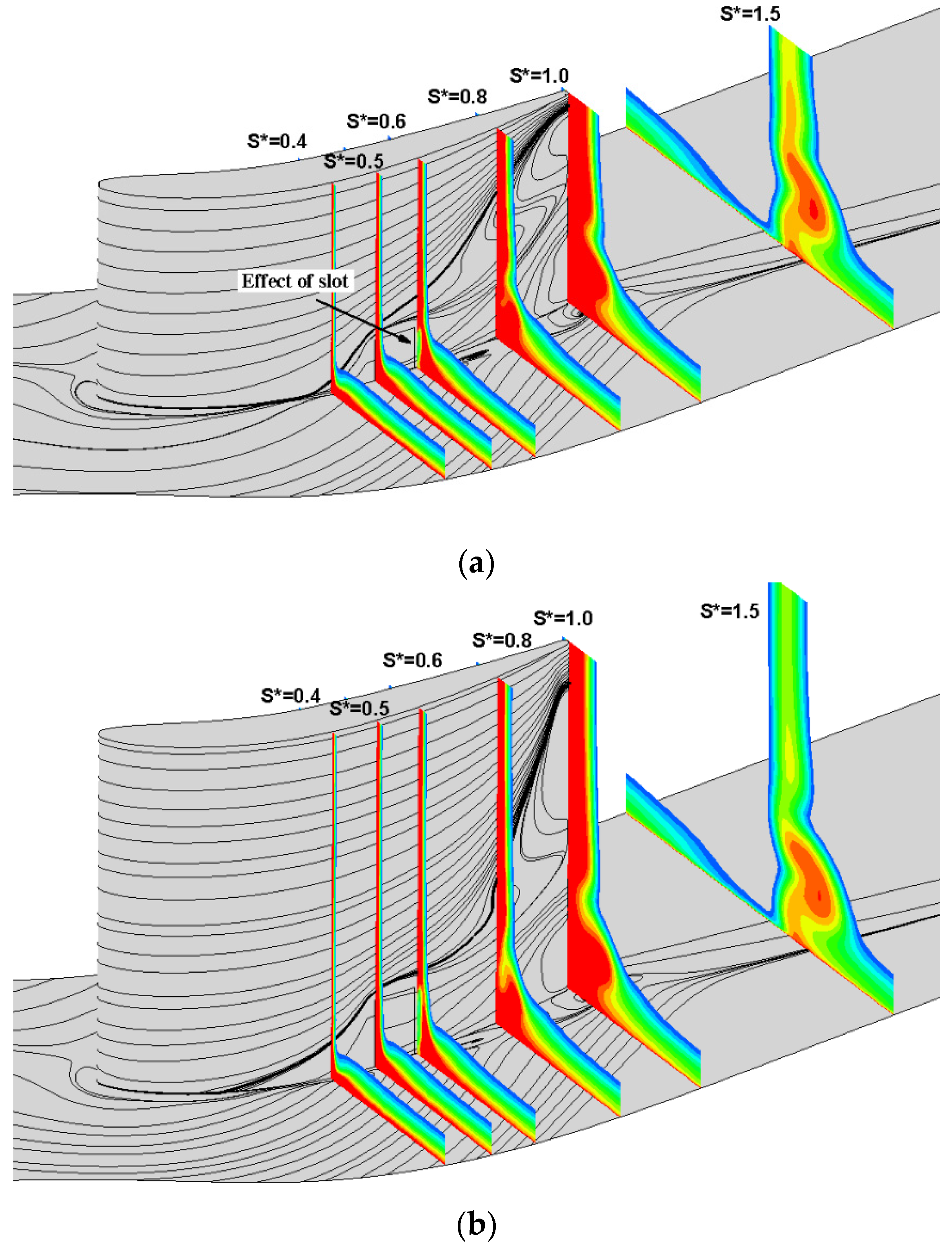
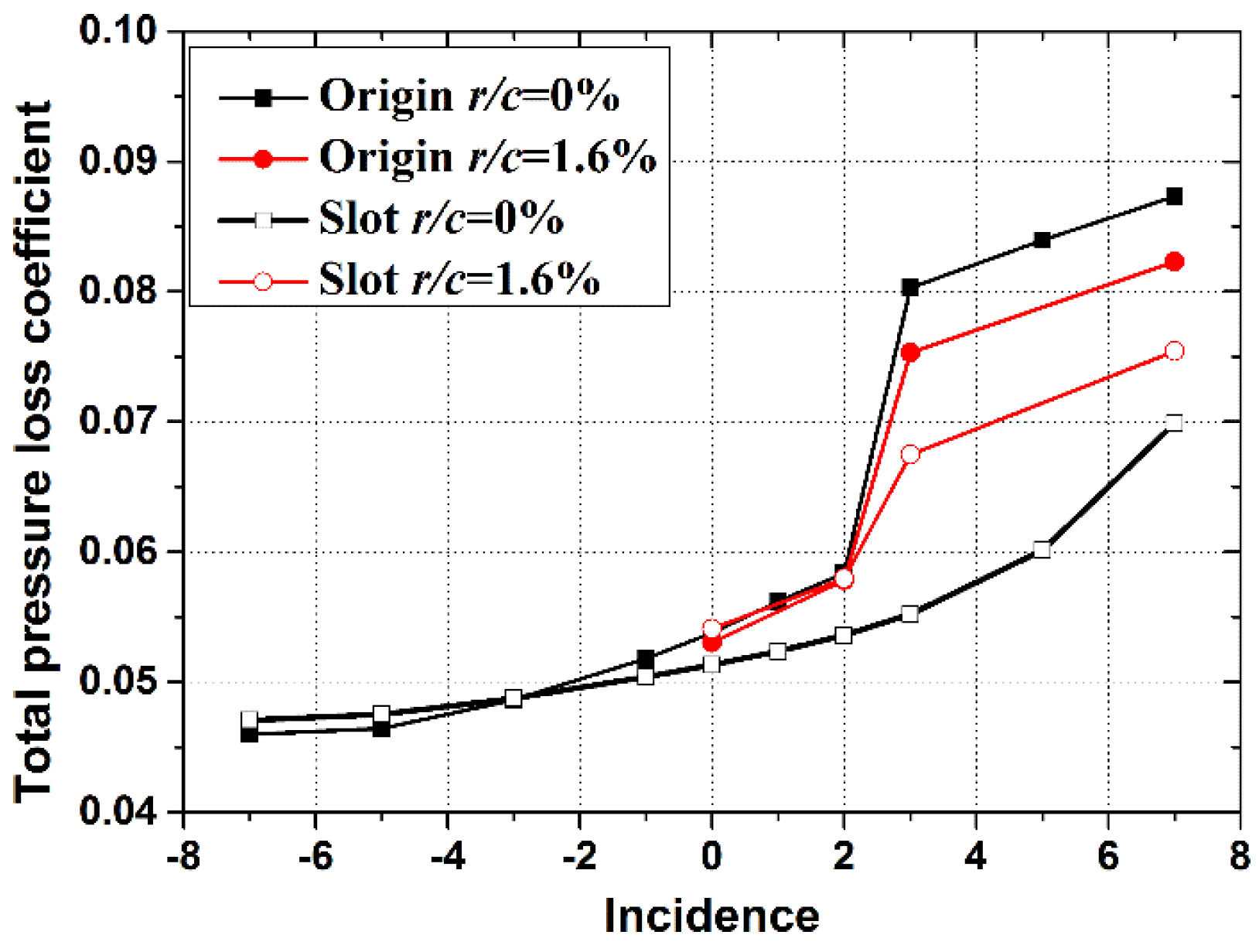
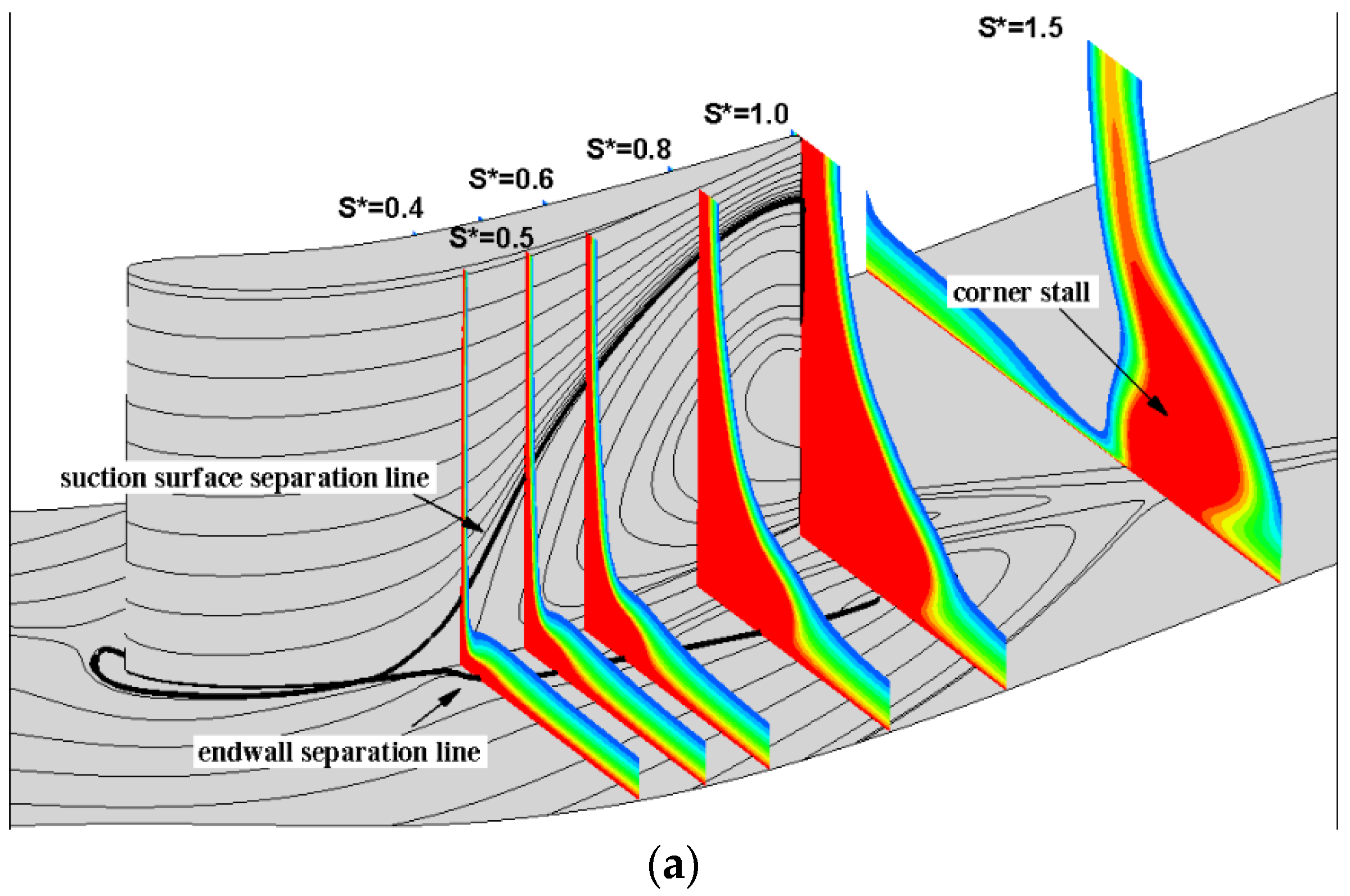
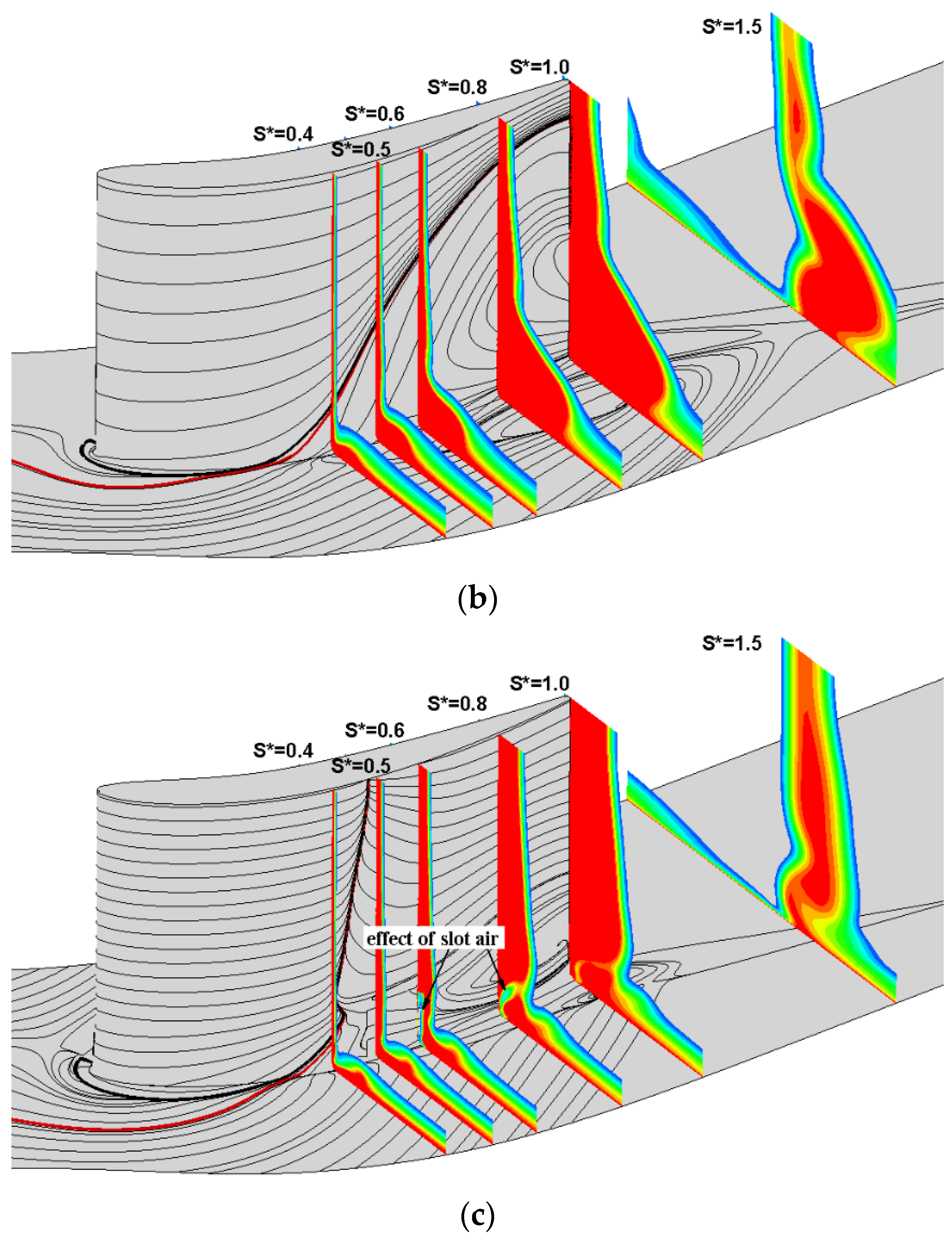
| Name | Symbol | Magnitude |
|---|---|---|
| Chord | c | 151.5 mm |
| Pitch to Chord | s/c | 0.926 |
| Aspect ratio | h/c | 1.32 |
| Camber angle | ψ | 14.7° |
| Stagger angle | γ | 42° |
| Reynolds number | Rec | 2.3 × 105 |
© 2016 by the authors; licensee MDPI, Basel, Switzerland. This article is an open access article distributed under the terms and conditions of the Creative Commons Attribution (CC-BY) license (http://creativecommons.org/licenses/by/4.0/).
Share and Cite
Liu, Y.; Sun, J.; Tang, Y.; Lu, L. Effect of Slot at Blade Root on Compressor Cascade Performance under Different Aerodynamic Parameters. Appl. Sci. 2016, 6, 421. https://doi.org/10.3390/app6120421
Liu Y, Sun J, Tang Y, Lu L. Effect of Slot at Blade Root on Compressor Cascade Performance under Different Aerodynamic Parameters. Applied Sciences. 2016; 6(12):421. https://doi.org/10.3390/app6120421
Chicago/Turabian StyleLiu, Yangwei, Jinjing Sun, Yumeng Tang, and Lipeng Lu. 2016. "Effect of Slot at Blade Root on Compressor Cascade Performance under Different Aerodynamic Parameters" Applied Sciences 6, no. 12: 421. https://doi.org/10.3390/app6120421






